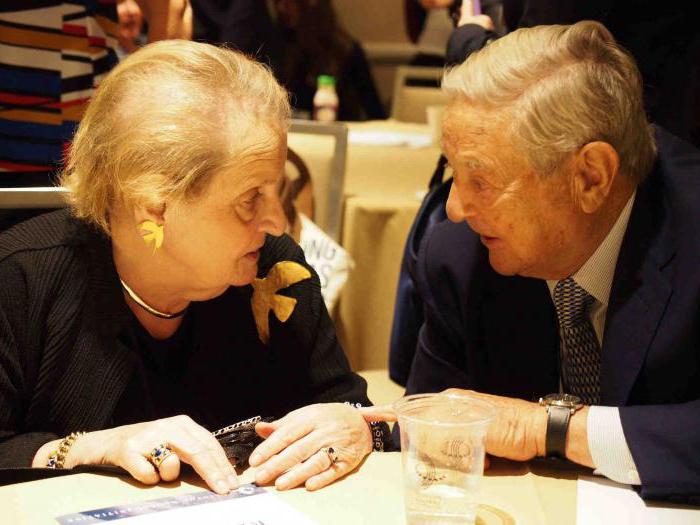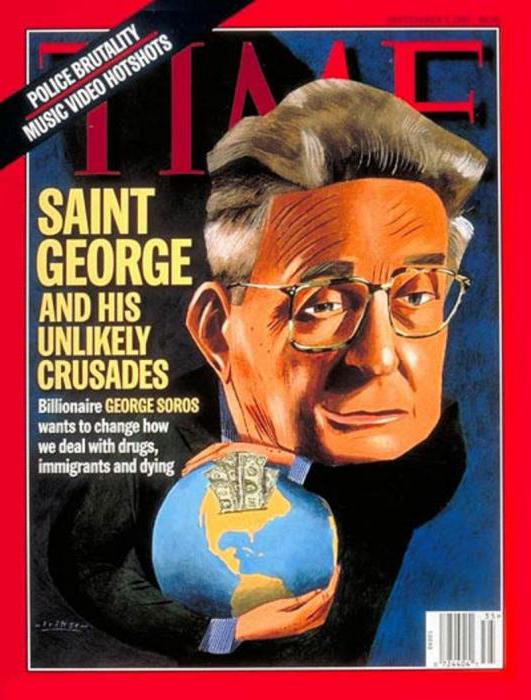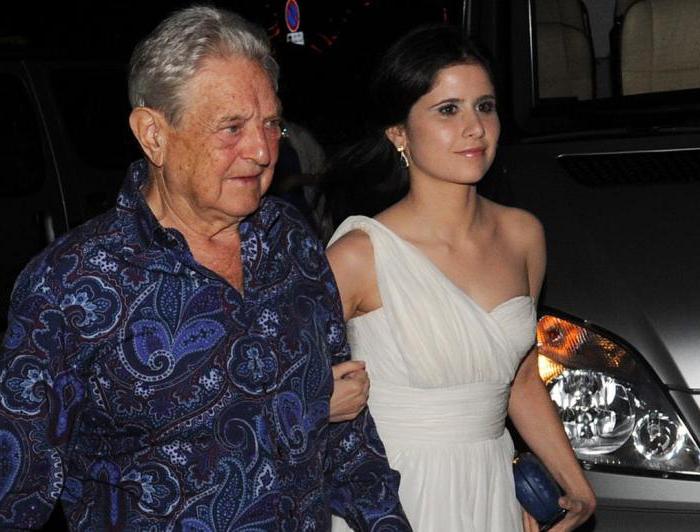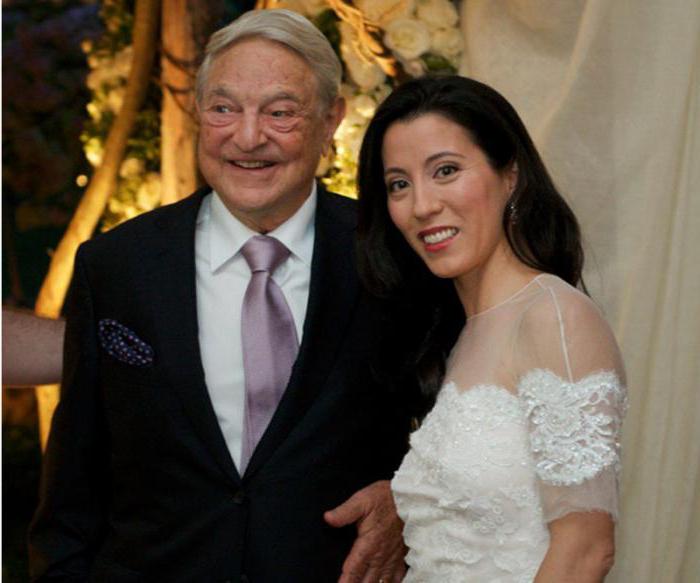American, hedge fund manager, philanthropist, business tycoon, investor, philosopher, writer and publicist. All this is George Soros. His short biography is as follows. He was born in Hungary on August 12, 1930 in a Jewish family. Before emigrating to England, and later the United States, survived the Nazi occupation and one of the most brutal battles of World War II in Budapest.
Financial genius
He is Chairman of Soros Fund Management, a hedge fund founded in 1969. After decades of success, the company returned money to most investors in 2011 to focus on managing assets owned by Soros. George, whose fortune exceeds $ 20 billion, is one of the richest people in the world. For all the time of its activity, the main revenue generator, Quantum Fund brought more than $ 40 billion in profit. A $ 1000 investment in the fund in 1969, according to some estimates, in 2000 turned into $ 4 million.
Investor George Soros is known as a very experienced short-term speculator, prone to daring adventures in the financial markets of the whole world. In 1992, he received the title of the person who bankrupted the Bank of England for trading operations during the so-called. black environment - currency crisis in the UK. Then the opening of a short position in pounds in the amount equivalent to $ 10 billion, brought him a profit of more than $ 1 billion.
His investment style was often controversial. Malaysian Prime Minister Mahathir Mohamad accused the billionaire of using his wealth to provoke the Asian financial crisis of 1997. True, years later, he will retract his accusation.
In 2002, Soros was convicted by a French court of appeal and fined € 2.2 million for allegedly selling Société Générale shares using insider information about the bank’s takeover.
In recent years, the famous financier appeared in the headlines as an ardent supporter of liberal values, a wealthy political donor and philanthropist. He heads the Open Society Foundation, founded in 1979 with the goal of "building dynamic and tolerant societies whose governments are responsible and open to the participation of all people."
Active philanthropist, from 1979 to 2011, Soros donated $ 8 billion for various purposes.

Youth and education
George Soros, whose biography began in Budapest (Hungary), in 1930, nine years before the outbreak of World War II, knew firsthand what it was. His father, Tivadar, was a prisoner of war during and after the First World War. His imprisonment ended when he fled from Russia to marry and begin his legal practice in Budapest. The family also did not shy away from trade. Soros's mother, Elizabeth, came from a family that held a silk shop.
Tiwadar was an avid supporter of Esperanto, a language that was invented in the late 1880s to help people overcome national differences and contribute to peace and understanding around the world. Oddly enough, Tivadar learned the language in the Russian camp where he was held, and whose commandant was an avid Esperanto. The idealism of the language inspired Tivadar, and he helped found a literary magazine in this artificial language. He also taught him the youngest son, and talked on him at home. In 1936, when Hitler hosted the Olympics in Berlin, Tivadar changed his family name from Schwartz to Soros, which in Esperanto means "soar."
In later interviews, George will say that his parents were non-religious Jews and cautiously expressed their religious background. In March 1944Nazi Germany occupied Hungary so that the country could not conclude an agreement with the rapidly advancing Western allies.
George Soros (photo) in his youth, when he was 13 years old, survived the arrival of the Nazi army, and for a long time he felt its presence in his life. The city authorities, collaborating with the Nazis, forbade Jewish children from attending school and the deportation of Jews from Budapest, mainly to the Auschwitz death camp, soon began.
The family of George Soros was hiding, he himself pretended to be the godson of an employee of the Ministry of Agriculture of Hungary. As a teenager, a financial genius worked with his father, making thousands of fake documents for people trying to escape from the Nazis. In later interviews, Soros called this time the finest hour of his father, referring to his nobility: to do free documents for people who were obviously threatened with deportation to death camps, only if necessary asking for modest compensation to cover the associated costs, but also demanding from the rich as much money as they could afford to pay.
In 1945, the battle for Budapest was raging - Soviet and German soldiers fought fierce street battles throughout the city. George survived the blockade and battles that claimed the lives of about 38,000 people over the course of three months. He was 14 years old.
With the end of the war, Soros left for England, where, penniless, he searched and found in London a society of Esperantists who sheltered him. Later, in 1947, he entered the London School of Economics (LSE). The future billionaire survived, working as a waiter and a loader on the railway.
At the LSE, he had the opportunity to learn from the philosopher Karl Popper, who is considered one of the greatest philosophers of science in the 20th century and the initiator of the term “open society”.
In 1951, Soros George graduated from the LSE with a bachelor of science degree in philosophy. He stayed for another three years to earn a Ph.D. in 1954.
Like many people with such an education, Soros found it difficult to get a job. Initially, he was engaged in the sale of goods along the coast of Wales. Being depressed, George began to systematically write letters to the managers of commercial banks in London. Most did not answer, but one letter hit the table for a compatriot, managing director of Singer & Friedlander, who offered the young man ordinary work.

George Soros: biography and photos
In 1954, the ex-salesman began working as a clerk at the London-based Singer & Friedlander merchant bank and eventually reached the level of the arbitration department. When he worked at the bank, one of George’s colleagues, Robert Mayer, recommended him to a position in the brokerage house of his father, F. M. Mayer.
George Soros, whose biography has changed dramatically with the acceptance of the offer to work as an arbitrage trader at F. M. Mayer, moved from London to New York in 1956. At that time, he specialized in European stocks when the creation of the Coal and Steel Community, later known as the Common Market, made his stocks popular among US investors. Having gained a reputation in this area, in 1959 he moved to Wertheim & Co as an analyst for European securities.
But Soros’s thoughts were in a different place. His plan was to keep working until he raised $ 500,000, which he believed would be enough to return to England for a comfortable study of philosophy.
Reflexivity theory
In those years, George developed the so-called. reflexivity theory. The idea came from the philosophy of his former teacher at the London School of Economics, Karl Popper. The concept of Soros was that self-awareness is part of a given environment. This meant that the act of evaluation in any market would necessarily be reflected in the actions of market participants, creating a virtuous or vicious circle within the market. In addition, any prediction can change the behavior of financial market entities, making a false statement true, or vice versa.
George realized that the idea can be used outside of philosophy.
According to Soros, the concept of reflexivity allowed him to take a different look at financial markets, better than the existing theory. This gave him an advantage, first as a securities analyst, and then as a hedge fund manager.
Instead of returning to London, George Soros continued his work, moving in 1963 to the New York bank Arnhold and S. Bleichroeder. Here he grew to the vice president, where his success convinced the company to contribute $ 100,000 to the investment fund he headed in 1966. This was the first great test of the philosophy of Soros, which he developed to a breathtakingly complex state.
According to the financier, he felt as though he owned a major discovery that would realize his fantasy to become an important philosopher. Going deeper and deeper, Soros was lost in the intricacies of his own designs. Then he decided to abandon philosophical research and focused on making money.
It worked. The following year, Arnhold and S. Bleichroeder allowed him to manage an offshore investment fund called First Eagle. Two years later, speculating on the success of the first enterprise, the company created the second, Double Eagle. It was a fund that eventually grew into a Quantum Fund.
In 1969, he was "seeded" with investment capital of $ 4 million, which included $ 250,000 of Soros' own funds. The investors were the Rothschild family and other wealthy Europeans.
The success of both funds lasted several years, and was stopped by federal rules regarding the alleged conflict of interest, the source of which was Soros. George resigned from Arnhold and S. Bleichroede. From Double Eagle, his own private investment company was created.
In 1973, the fund was renamed Soros. George managed assets of $ 12 million in conjunction with Jim Rogers Over the years, they will reinvest their income, along with most of the annual commissions of 20%.

Quantum mechanics
Soon after the physicist Werner Heisenberg discovered the principle of quantum mechanics, the investment company was renamed the Quantum Fund. And she began to bring fabulous income. Unbound by the multitude of rules restricting mutual fund managers today, Soros could and was willing to play lower during inflation and oil shortages. Between 1969 and 1980, the Quantum Fund grew by a staggering 3365% compared to 47% of the S & P500.
By 1981, the assets already had $ 400 million, but this year he faced a loss of 22% after an unsuccessful operation with interest rates. Investors fled, leaving only $ 200 million in assets. Soros took a vacation, delegating daily fund management, to study global and monetary policies, as well as other driving forces of inflation, interest rates and exchange rates.
By George's return in 1984, lost assets were recovered. Armed with ideas gleaned from his creative vacation, he immediately began to make big bets. In 1985, the fund earned 122% profit, and George himself earned $ 93 million.
With the growth of the Quantum Fund, Soros's reputation as one of the best money managers in the world has grown. In 1987, he took advantage of this to promote his philosophy. His book, Alchemy of Finance, touches on the intellectual basis of his investment strategy.
Towards the end of the 1980s, financier George Soros began to pay attention to events in Eastern Europe. He again handed over the current management of the fund in 1989, this time to his protege Stanley Druckenmiller, who continued to provide high returns.
This and improved reputation have allowed Quantum Fund to continue to grow. In 1997, the fund was reorganized into a limited liability company in which Soros, Druckenmiller, and chief administrative officer Gary Gladstein jointly managed the company and its six foundations. By mid-1998, the firm oversaw about $ 21.5 billion.
This success in favor of customers continued with a few hitches until July 2011. It was then that Soros, worried about the new S.E.C. rules. information disclosure could jeopardize the privacy of its customers, returned investor funds and invested $ 24.5 billion of its own funds in Quantum Fund. In 2013, the fund received an income of $ 5.5 billion.

Asset value
Soros George, whose fortune in September 2015 amounted to $ 26 billion, according to Forbes, is the 21st the richest man in the world. A modest education in pre-war Hungary allowed him to get 10 out of 10 points to assess the degree of independence in achieving the success of Forbes magazine. This means that he received his fortune without assistance.
But the position of Soros at the top of the list of billionaires may be in danger due to the tax service. Soros Fund Management, which manages most of its wealth, has accumulated about $ 13 billion of its assets thanks to the generous tax deferrals granted to US hedge funds until 2008.
These delays allowed the financier to defer payment of taxes on remuneration to customers, and reinvest them. Such a loophole allowed Soros's tax-free income to continue to grow. The problem is that Congress has closed this opportunity, and anyone who has used it for many years will have to pay deferred taxes as of 2017.
Given that Soros is based in New York and is subject to the highest tax rate, he will have to pay state and city taxes of 12% plus 3.8% of Obamacare's investment income. And all this after he pays the federal government 39.6%.
According to some estimates, Soros' tax liabilities amount to approximately $ 6.7 billion. He is an active supporter of liberal principles and encourages tax increases, increased government spending and regulation. So it will be interesting how he parted with a significant part of his own fortune.
Convinced democrat
When it comes to politics, Soros, up to this point, confirmed his words with money. In the 2014 election, he spent $ 3,763,400 on Democratic candidates. His son invested another $ 1.7 million. According to some estimates, from 1998 to 2010, the Billionaire and his funds contributed more than $ 12 million to lobbying for leftist sentiments. Despite the fact that this pales in comparison with the $ 50 million Koch brothers who contributed to the right period, who lobby for the right bias, nevertheless this is a huge amount of money.
One of the ways Soros can try to lose less is through his charitable endeavors. Over the years, he gave over 8 billion US dollars.
In 2012, the Open Society Foundation provided over $ 364 million in grants to 3,300 organizations, plus $ 14 million to 850 individuals. In 2009, the famous philanthropist donated $ 100 million to help Central and Eastern Europe to recover from the effects of the global financial crisis.
His Open Society foundation is the main recipient of his fortune, and it seems that he is likely to continue working for a long time to come. In 2011, the fund rented for 14 years 14,000 square meters. m square "Gold digger buildings" on West 57th Street in Manhattan. Previously, the building was the New York headquarters of General Motors.
In addition to his $ 9.8 million mansion and complex in Cato, New York, the Soros family regularly appears in the New York real estate market. In 2014, his ex-wife put up for sale her townhouse on the Upper East Side for $ 31 million, and his daughter offers a townhouse in Greenwich Village for $ 25 million. The year before, his son, an artist, was about to sell his townhouse in the Manhattan area of Nolita for a little over $ 10 million.

The man who broke the Bank of England
George Soros (photo) was a lightning rod for criticism. His bold financial maneuvers and frank policy made his surname a household name.
In 1992, Soros made one of the biggest bets in his career, which concerned the assessment of the British pound by the European exchange rate mechanism. The mechanism was developed in 1979 to reduce exchange rate volatility across Europe.
George believed that the rate of this mechanism for the pound was extremely unbalanced. The UK was experiencing inflation, 3 times higher than in Germany, interest rates in the UK reached the point where they began to harm asset prices.
Drakenmiller, then a trader who worked for Soros, first discovered the opportunity created by the faulty European exchange rate mechanism. George persuaded him to go all-in. On September 16, 1992, the Quantum Fund borrowed £ 5 billion and quickly exchanged currency for German marks.
Such a volume of trade was to prove that the Bank of England could not support the value of the pound. Soros was right. The market forced the British government to spend £ 27 billion in one day to support the pound. His efforts were unsuccessful, and the UK ultimately withdrew from the European exchange rate mechanism, which greatly devalued the pound.
This was exactly what Soros was counting on. George took a short position worth more than $ 10 billion in pounds. The deal brought more than $ 1 billion in profit. In addition, the fund earned another billion US dollars in tenders in Italian lira and Swedish krona.
For a year, Soros bankrupted the Bank of England and personally earned $ 650 million.

Brazilian soap opera
George Soros married a third time to 42-year-old Tamiko Bolton in 2013. His first and second marriages lasted 23 years and 18 years, respectively.
But the details of his personal life became public in 2011 when his ex-girlfriend Adriana Ferreir filed a lawsuit in the amount of $ 50 million with allegations of fraud, violence, moral damage and assault. The former soap opera actress met with the famous financier for 5 years.
In 2014, most of the charges were dropped, with the exception of moral damage and bodily harm. Ironically, Ferreira allegedly herself attacked Soros and his lawyer in 2014 while testifying after they refused to allow filming of the trial.
At some point, Soros offered Ferreir $ 6.7 million for a waiver of the lawsuit. Her lawyer will subsequently sue her for refusing to agree to such an agreement. The ex-actress will change lawyers twice more and personally represent herself in the lawsuit against Soros when the Manhattan Supreme Court dismisses him in February 2015.

George Soros. Biography. Family
George's brother, Paul, was born June 5, 1926. He is the founder of Soros Associates, which designs and builds port facilities for bulk transport. He fled to the United States from persecution during the occupation of Hungary by the Soviet Union in 1948. He was educated at the Polytechnic Institute in Brooklyn. In 1998, together with his wife, Daisy founded a scholarship to educate immigrants and their children. The four have two sons - Peter and Jeffrey.
How old George Soros is is easy to calculate. In 2016, he turns 86. Over the years, he managed to get married three times.
The first wife of Soros, an ethnic German woman, Annalize Witschak, who lost her parents during World War II, married him in 1960. She gave birth to three children - Robert Daniel (1963), Andrea (1965) and Jonathan Tivadar (1970). Divorced in 1983
The second wife (since 1983) - Susan Weber (b. 1954). She divorced in 2005. She founded and is the director of the center for the study of art, the history of design and material culture. Prior to that, she was Executive Director of the Open Society Institute, which was founded by George Soros. The children from this marriage are Alexander (1985) and Gregory James (1988).
The third wife (since 2013), Tamiko Bolton (b. 1971), owns an online business selling dietary supplements and vitamins. He holds a Master of Business from the University of Miami.
Here he is, George Soros.The biography and success story of the financier and philanthropist are far from over. The man who made billions of dollars from his predictions published another forecast on February 11, 2016 in the British newspaper The Guardian.
According to Soros, in 2017 Russia faces a default when the time comes to pay most of its external debt, and political instability, restrained as long as the government ensures financial stability and a slow but steady increase in living standards, breaks out even earlier. The combination of Western sanctions with a sharp decline in oil prices will cause the fall of the ruling regime. Let's see if the predictions of the great visionary come true this time.








